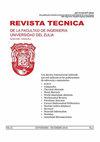本研究的目的是评估墨西哥玉米(Zea mays L.)地表和地下滴灌的用水效率。
Q Engineering
Revista Tecnica De La Facultad De Ingenieria Universidad Del Zulia
Pub Date : 2021-04-01
DOI:10.22209/RT.V44N2A02
引用次数: 1
摘要
在粮食生产中,水是一个限制因素;因此,有必要在农业系统中最大限度地利用这种资源。对玉米地表滴灌和地下滴灌的水分利用效率进行了评价。选用硬质杂交种玉米1600 m2,采用4个处理,分别为浅表滴灌(T1、对照)和10 (T2)、20 (T3)和30 (T4) cm深地下滴灌,重复4次。采用随机区组设计,每个试验单元为100 m2 (10 m × 10 m),测定产量、水分利用效率(WUE)、灌溉频率、灌溉时间、灌溉片数、湿球茎直径。除每次灌溉水量外,其余各变量均有统计学差异(p<0.01)。产量(10263 kg/ha)、水分利用效率(7.92 kg/m3)、湿球直径(0.145 m)均高于T3和T4;灌溉次数(3.6 d)和总水量在T3和T4较低(129 mm);T4期总灌溉时间较短(34.08 h), 20和30 cm深度的地下滴灌效率最高。本文章由计算机程序翻译,如有差异,请以英文原文为准。
Eficiencia de Uso del Agua en Riego por Goteo Superficial y Subsuperficial en Zea mays L.
In food production, water is a limiting factor; therefore, it is necessary to achieve maximum efficiency in the use of this resource in agricultural, systems. The efficiency of the water use of surface and subsurface drip irrigation in the Zea mays L. crop was evaluated. 1,600 m2 of hard hybrid corn were cultivated, with four treatments: superficial drip irrigation (T1, control) and subsurface at 10 (T2), 20 (T3) and 30 (T4) cm deep and four repetitions. In a randomized block design, each experimental unit was 100 m2 (10 m x 10 m). The yield, water use efficiency (WUE), frequency, time and irrigation sheet, diameter of the wetted bulb were measured. There were statistical differences for all the variables evaluated (p<0.01), except for the sheet of water per irrigation due to the effect of the treatments. Yield (10,263 kg/ha), WUE (7.92 kg/m3), diameter wet bulb (0.145 m) were higher in T3 and T4; the frequency of irrigation (3.6 days) and the total sheet of water was lower in T3 and T4 (129 mm); the total irrigation time was shorter in T4 (34.08 h). Subsurface drip irrigation at 20 and 30 cm depth showed the highest efficiency.
求助全文
通过发布文献求助,成功后即可免费获取论文全文。
去求助
来源期刊
CiteScore
0.13
自引率
0.00%
发文量
6
审稿时长
>12 weeks
期刊介绍:
La Revista Técnica de Ingeniería, es un órgano de publicaciones científicas y divulgativas de la Facultad de Ingeniería de la Universidad del Zulia. Es una Revista que se publica cuatrimestralmente en tres números correspondiente a un volumen anual. En esta se presentan destacados trabajos de investigación de la comunidad Científico-Tecnológica Nacional e Internacional, proveniente de Universidades, centros de Investigación e Institutos Nacionales y del Extranjero. Cada número circula el primer día de Enero, Mayo y Septiembre, espectivamente, desde el año 2016 al iniciar como Revista en formato digital.

 求助内容:
求助内容: 应助结果提醒方式:
应助结果提醒方式:


